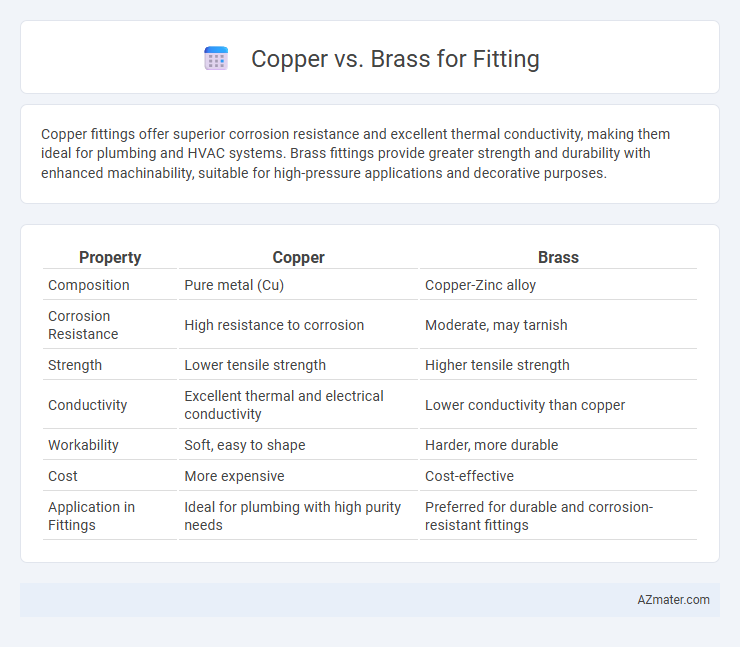Copper fittings offer superior corrosion resistance and excellent thermal conductivity, making them ideal for plumbing and HVAC systems. Brass fittings provide greater strength and durability with enhanced machinability, suitable for high-pressure applications and decorative purposes.
Table of Comparison
| Property | Copper | Brass |
|---|---|---|
| Composition | Pure metal (Cu) | Copper-Zinc alloy |
| Corrosion Resistance | High resistance to corrosion | Moderate, may tarnish |
| Strength | Lower tensile strength | Higher tensile strength |
| Conductivity | Excellent thermal and electrical conductivity | Lower conductivity than copper |
| Workability | Soft, easy to shape | Harder, more durable |
| Cost | More expensive | Cost-effective |
| Application in Fittings | Ideal for plumbing with high purity needs | Preferred for durable and corrosion-resistant fittings |
Introduction to Copper and Brass Fittings
Copper fittings are highly valued for their excellent corrosion resistance, thermal conductivity, and durability, making them ideal for plumbing and HVAC systems. Brass fittings, an alloy of copper and zinc, offer superior machinability, strength, and resistance to dezincification, often used in applications requiring robust performance and aesthetic appeal. Both materials provide reliable connections, but copper excels in pure metal conductivity while brass offers enhanced mechanical properties for demanding fitting applications.
Chemical Composition and Properties
Copper fittings consist primarily of pure copper, known for excellent thermal and electrical conductivity, corrosion resistance, and antimicrobial properties, making them ideal for plumbing and heating applications. Brass fittings, an alloy of copper and zinc, exhibit higher strength and better machinability while maintaining good corrosion resistance, with zinc content typically ranging from 5% to 40%, influencing hardness and durability. The difference in chemical composition results in copper being more malleable and conductive, whereas brass offers enhanced mechanical strength and wear resistance for diverse fitting requirements.
Durability and Longevity Comparison
Copper fittings exhibit superior corrosion resistance and maintain structural integrity under high temperatures, ensuring long-term reliability in plumbing systems. Brass fittings offer enhanced strength and resistance to dezincification, making them durable in marine and industrial applications. Both materials provide excellent longevity, but copper's natural anti-microbial properties and superior oxidation resistance generally result in a longer lifespan in residential water supply systems.
Corrosion Resistance in Plumbing Applications
Copper exhibits superior corrosion resistance in plumbing applications due to its natural oxide layer that prevents rust and degradation over time. Brass, an alloy of copper and zinc, offers good corrosion resistance but is more prone to dezincification, especially in acidic or chlorinated water environments. Choosing copper fittings ensures longer durability and reliability in plumbing systems exposed to varying water qualities.
Cost Analysis: Copper vs Brass
Copper fittings typically have a higher upfront cost due to the raw material price, but they offer superior durability and corrosion resistance, leading to lower long-term replacement expenses. Brass fittings, while generally more affordable initially, may incur higher maintenance costs over time because of their susceptibility to dezincification and potential leaks. Evaluating total cost of ownership favors copper in applications demanding longevity and reliability despite the higher initial investment.
Installation Process and Ease of Use
Copper fittings offer straightforward installation with soldering, providing reliable, leak-proof joints that require a propane torch and flux for proper sealing. Brass fittings are known for their ease of use due to threaded connections, enabling quick, tool-tightened assembly without heat, making them ideal for maintenance or adjustments. Both materials ensure durability, but brass fittings reduce installation time and complexity, especially in confined spaces or when frequent disassembly is anticipated.
Compatibility with Different Plumbing Systems
Copper fittings offer excellent compatibility with a wide range of plumbing systems, including potable water, heating, and gas lines, due to their corrosion resistance and ability to withstand high temperatures. Brass fittings, composed of copper and zinc, provide superior strength and durability, making them suitable for high-pressure systems and applications involving water, air, and steam. Both materials require proper sealing methods to prevent galvanic corrosion when connected to dissimilar metals in mixed plumbing systems.
Environmental Impact and Recyclability
Copper fittings exhibit lower environmental impact due to their higher recyclability rate, with copper being 100% recyclable without quality loss, reducing mining demands and energy consumption. Brass fittings, an alloy of copper and zinc, are also recyclable but require more energy in recycling processes due to the mixed metals, slightly increasing environmental footprint. Choosing copper fittings supports circular economy initiatives by minimizing resource extraction and promoting sustainable material reuse.
Common Applications for Copper and Brass Fittings
Copper fittings are widely used in plumbing, HVAC systems, and refrigeration due to their excellent corrosion resistance, thermal conductivity, and antimicrobial properties. Brass fittings are preferred in water supply lines, gas distribution, and marine applications because of their durability, machinability, and resistance to dezincification. Both metals provide reliable sealing and mechanical strength, but copper excels in high-temperature environments while brass offers better corrosion resistance in low-pressure systems.
Choosing the Right Fitting Material
Choosing the right fitting material depends on factors like corrosion resistance, durability, and application environment. Copper fittings offer excellent thermal conductivity and resistance to corrosion, making them ideal for plumbing and HVAC systems. Brass fittings provide superior strength and machinability, which suits high-pressure applications and fixtures requiring precision threading.

Infographic: Copper vs Brass for Fitting
 azmater.com
azmater.com